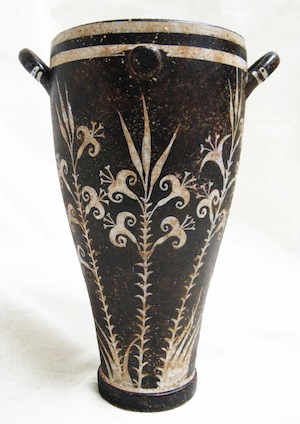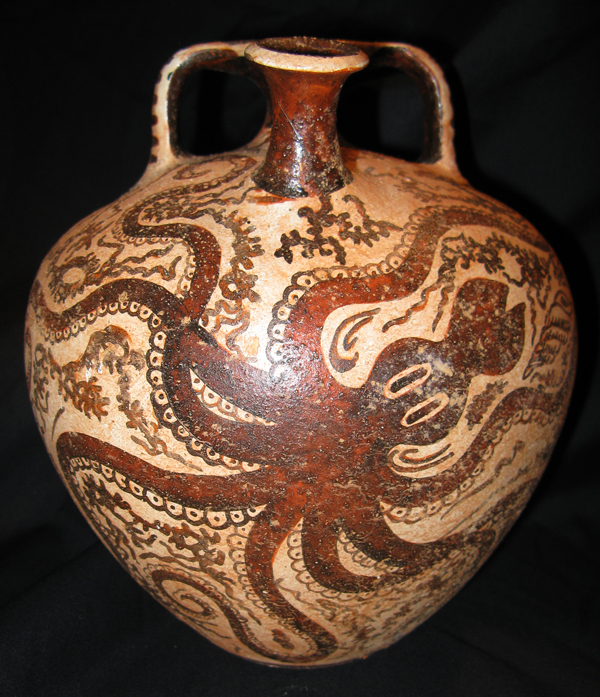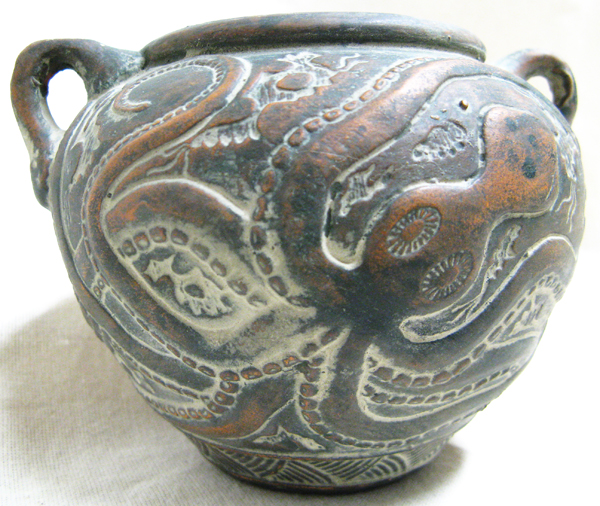The Minoan civilization was based on the island of Crete during the Bronze Age. The capital of the Minoan culture was situated at Knossos, a site excavated by Sir Arthur Evans after 1900. During their most developed stages, the Minoans built great palaces, employed languages called Linear A and Linear B, and produced fine frescoes and pottery, much of which depicted marine and agricultural themes. It is believed that between 1500 and 1450 B.C. the decline of this civilization was caused by an earthquake and the eruption of the volcanic island of Thera.
Pottery

Lily Vase
Minoan
replica: from World Treasures, California
date of the original: c. 1600-1580 BC (Late Minoan I)
provenance of the original: Palace of Knossos, Crete; now in the Herakleion Museum, Crete
description: Brown glazed vessel with cream-white glaze in lily motif. Pottery replica; pottery original. Height 20 cm (tapered, straight at the bottom increasing in circumference to the top), diameter 14 cm.
Slightly earlier than the Octopus Stirrup Jar, this vase indicates the development of a preoccupation with natural subjects and a naturalistic advance in representational art. Like many subjects of the Late Minoan period the lilies perhaps took their inspiration from wall paintings--a mural from Amnissos has this same lily motif which transfers well to the surface of pottery. The small clump of leaves at the bottom where the vase is at its narrowest expands upward into blossoms where the vase reaches it widest circumference.

Octopus Stirrup Jar
Minoan
replica: from World Treasures, California
date of the original: c. 1500 BC
provenance of the original: Palace of Knossos, Crete; now in the Herakleion Museum, Crete
description:Jar or amphora with false neck. Octopus motif with coral, seaweed and shell fillings. Cream glaze with brown-rust figures. Pottery replica; pottery original. Height 18 cm, diameter 16.5 cm.
Here as in many other similar vessels (see: Bronze Octopus Cup), the octopus swims diagonally, with rocks and shells filling the spaces between the tentacles. The stirrup jug is so-named from its stirrup shaped handles. This particular jug has a false neck--the insertion of an extra spout was to facilitate pouring.
This stirrup jar, with its octopus design, is typical of the Late Minoan period which had reached a high point in foreign expansion and vigorous economic activity. The pottery of this period is characterized by an exuberant joy in nature; the motifs are more naturalistic and there is a greater sense of movement. There is no three-dimensional illusionism; rather the impact of the painting comes from the shapes of the motifs and their relationship to the vessel’s shape and contours. The marine elements, like the octopus (cuttlefish), work well because their shapes are simple, irregular and sinuous, and thus allow a ready transition to two-dimensional form. The marine style is also characterized by the desire to fill every available space with some ornamentation.

Bronze Octopus Cup
Minoan
replica
gift of: Professor and Mrs. L.C. Coleman
date: Middle to Late Minoan Period (c. 2200-1500 BC)
provenance: unknown
description: A two-handled bronze cup with octopus design on body. Bronze-patinated resin replica; bronze original. Height 10 cm, diameter 13 cm.
On this vessel, an octopus is depicted swimming diagonally, with tentacles, rocks and shells filling most empty spaces. The vessel appears to be an alabastron, or ointment jar. (See also: Octopus Stirrup Jar.)
A preference for marine subjects on wall frescoes was in evidence in the Middle Minoan III period at Knossos, on Crete. This subject matter had little influence on vase painting until the Late Minoan 1B phase, though it is evidenced on other media such as exquisite steatite vessels, dating to the Middle Minoan III period.
In line with the intaglios and reliefs executed on these steatite vessels come various marine designs taken over into repousse metalwork, as seen on this bronze vessel.